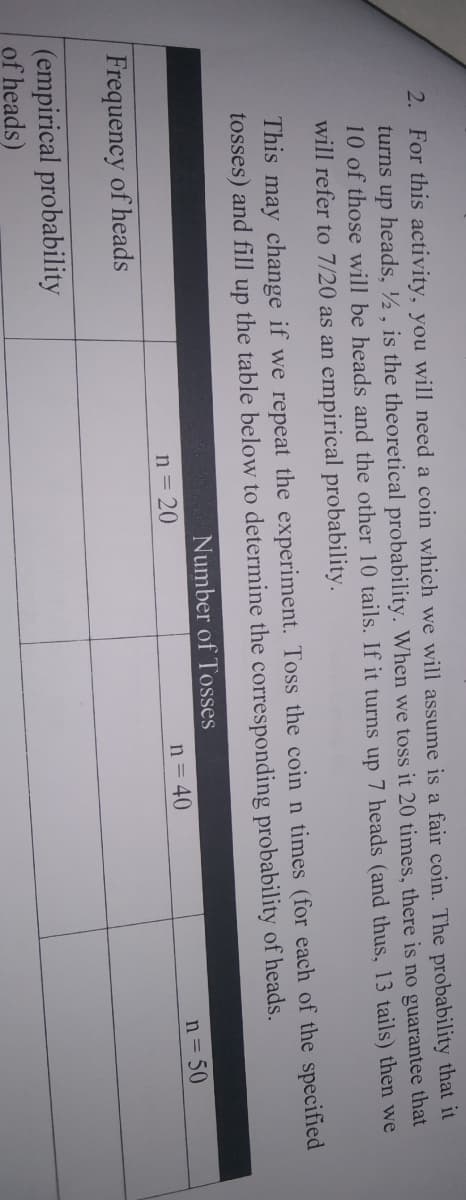2. For this activity, you will need a coin which we will assume is a fair coin. The probability thát I0 turns up heads, ½ , is the theoretical probability. When we toss it 20 times, there is no guarantee that 10 of those will be heads and the other 10 tails. If it turns up 7 heads (and thus, 13 tails) then we will refer to 7/20 as an empirical probability. This may change if we repeat the experiment. Toss the coin n times (for each of the specified tosses) and fill up the table below to determine the corresponding probability of heads. Number of Tosses n = 20 n = 40 n= 50 Frequency of heads (empirical probability of heads)
2. For this activity, you will need a coin which we will assume is a fair coin. The probability thát I0 turns up heads, ½ , is the theoretical probability. When we toss it 20 times, there is no guarantee that 10 of those will be heads and the other 10 tails. If it turns up 7 heads (and thus, 13 tails) then we will refer to 7/20 as an empirical probability. This may change if we repeat the experiment. Toss the coin n times (for each of the specified tosses) and fill up the table below to determine the corresponding probability of heads. Number of Tosses n = 20 n = 40 n= 50 Frequency of heads (empirical probability of heads)
Chapter8: Sequences, Series,and Probability
Section8.7: Probability
Problem 11ECP: A manufacturer has determined that a machine averages one faulty unit for every 500 it produces....
Related questions
Concept explainers
Contingency Table
A contingency table can be defined as the visual representation of the relationship between two or more categorical variables that can be evaluated and registered. It is a categorical version of the scatterplot, which is used to investigate the linear relationship between two variables. A contingency table is indeed a type of frequency distribution table that displays two variables at the same time.
Binomial Distribution
Binomial is an algebraic expression of the sum or the difference of two terms. Before knowing about binomial distribution, we must know about the binomial theorem.
Topic Video
Question
100%

Transcribed Image Text:2. For this activity, you will need a coin which we will assume is a fair coin. The probability that it
turns up heads, ½ , is the theoretical probability. When we toss it 20 times, there is no guarantee that
10 of those will be heads and the other 10 tails. If it turns up 7 heads (and thus, 13 tails) then we
will refer to 7/20 as an empirical probability.
This may change if we repeat the experiment. Toss the coin n times (for each of the specified
tosses) and fill
the table below to determine the corresponding probability of heads.
up
Number of Tosses
n = 20
n = 40
n = 50
Frequency of heads
(empirical probability
of heads)
Expert Solution
This question has been solved!
Explore an expertly crafted, step-by-step solution for a thorough understanding of key concepts.
This is a popular solution!
Trending now
This is a popular solution!
Step by step
Solved in 2 steps

Knowledge Booster
Learn more about
Need a deep-dive on the concept behind this application? Look no further. Learn more about this topic, probability and related others by exploring similar questions and additional content below.Recommended textbooks for you


College Algebra
Algebra
ISBN:
9781305115545
Author:
James Stewart, Lothar Redlin, Saleem Watson
Publisher:
Cengage Learning


College Algebra
Algebra
ISBN:
9781305115545
Author:
James Stewart, Lothar Redlin, Saleem Watson
Publisher:
Cengage Learning